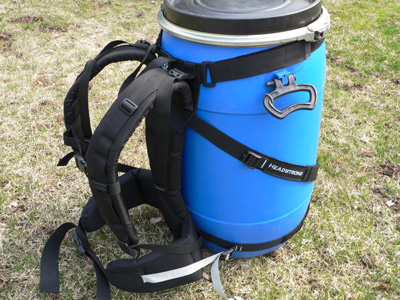

Properly hanging your food on a wilderness camping trip can mean the difference between eating regularily and going hungry. Depending on where your camping or canoe trips takes you, you must protect your food from both large animals such as bears and small animals such as racoons.
Where food storage methods have been provided for you make sure you use them. These methods are often found in State, Provincial, or Federal parks where bears, racoons and other animals have become a problem due to years of careless campers and abundance of easily available food (due to said careless campers). To discourage bears from visiting campgrounds, park authorities provide various methods of hanging or storing food - use them if available.
On a wilderness canoe or backpacking trip, however, you won't have the convenience of a pre-made food hanging or storage device - you'll have to devise your own. I bring the following with me on every hiking and canoe trip.
Food Hanging Kit
In order of preference, the following three methods describe how to hang your food in a tree or trees such that it minimizes the possibility of it being detected and eaten by hungry animals. A short discussion on the use of a food barrel then follows. In each case, consider these tips:
This method has the advantage that you don't have to find a good "hanging branch". In some types of forests in may be darn-near impossible to find a branch that meets the requirements for hanging a heavy food bag.
In the photo below, two ropes and a pulley are used to create a hanging system that is easy to rig. The centre line rope (green) is first thrown over a high branch on one tree and secured to the trunk. Then bring the remaining rope over to a second tree and throw the rope over a high branch. Before making the centre line taut, make a loop at the centre point, and attach the carabiner and pulley (with the second rope threaded through). Now pull on the first rope to raise the pulley and make the center line taut. Now you can raise and lower your food bag(s) as needed using the second (yellow) rope.
The same system can be used if you only have one rope by simply securing your food pack directly to the center line (green) before it is pulled taut and secured to the base of the second tree.
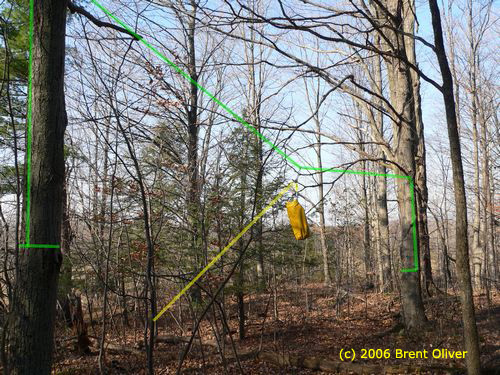
Similar to the method above, this method can be used when a suitable branch can be found. A strong branch that extends well out from the trunk takes the place of the centre line. Instead, the first rope (green) is used to attach the carabiner/pulley combination, and then hoisted up near the branch. (Don't forget to thread the second rope (yellow) through the pulley before hoisting the pulley up.)
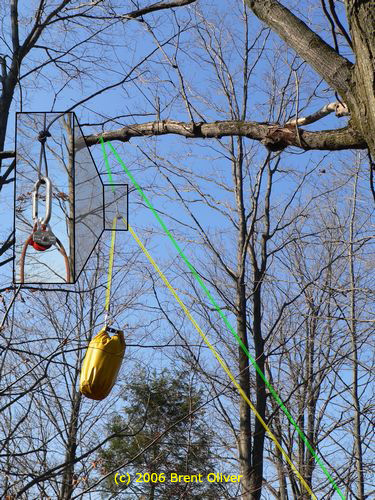
A variation on the single branch - pulley method is to introduce a third rope. This adaption can be useful when you can't find a large, high branch that extends far enough away from the tree's trunk.
The third rope (purple) is secured to the food pack before it is hoisted up. Once the pack is hoisted in the air and tied off, use the third rope to pull the food bag away from the tree trunk. You may need to adjust how high you hoist the food bag - too high, and you will be pulling the food bag too close to the main supporting branch as you pull it away from the trunk.
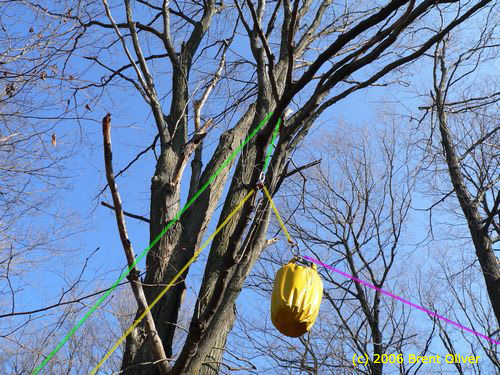
Simple Single-Rope, Single-Branch Method
This is the typical method used by less experienced wilderness campers. It involves simply finding a large branch and throwing a rope over it and then hoisting up the food bag. I've even seen a food bag hoisted in this manner almost directly over a tent - a sure sign of an inexperienced camper.
There are a few problems with this method:
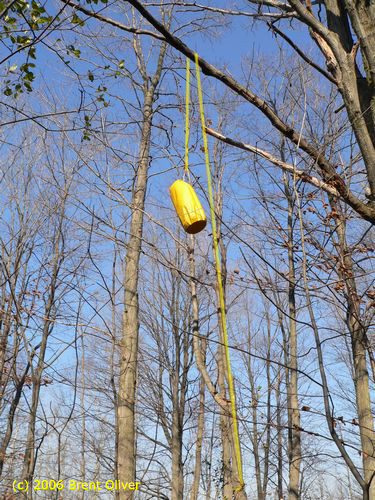
Due to the fact that a barrel is air-tight it is commonly believed that food can safely be left on the ground in the barrel rather than rigging a rope system for hauling your food into the air.
This method is certainly more convenient. However, if a bear did decide to see what is inside it likely wouldn't have much trouble getting at the contents. To minimize the risk that a bear becomes curious about the contents make sure that any food spills on the outside of the barrel and lid are cleaned up thoroughly. As a general rule, do not do dinner prep using the barrel lid.
So far, with over 20 years of backcountry camping using a 60 L canoe barrel, our food has remained safe when stored in the barrel. We're keeping our fingers crossed!
The Headstrong barrel harness pictured to the right has been a great harness, comfortable and bullet-proof and still in use in 2024. Unfortunately, it loooks like Headstrong Packs may be out of business. As of 2012, more than 6 years after the purchase of the harness and the company website no longer exists. Too bad.
Other barrel harnesses worth considering are North Water Quick Haul Harness, Recreational Barrel Works (RBW) and Ostrom Outdoors Voyageur Barrel Harness.
